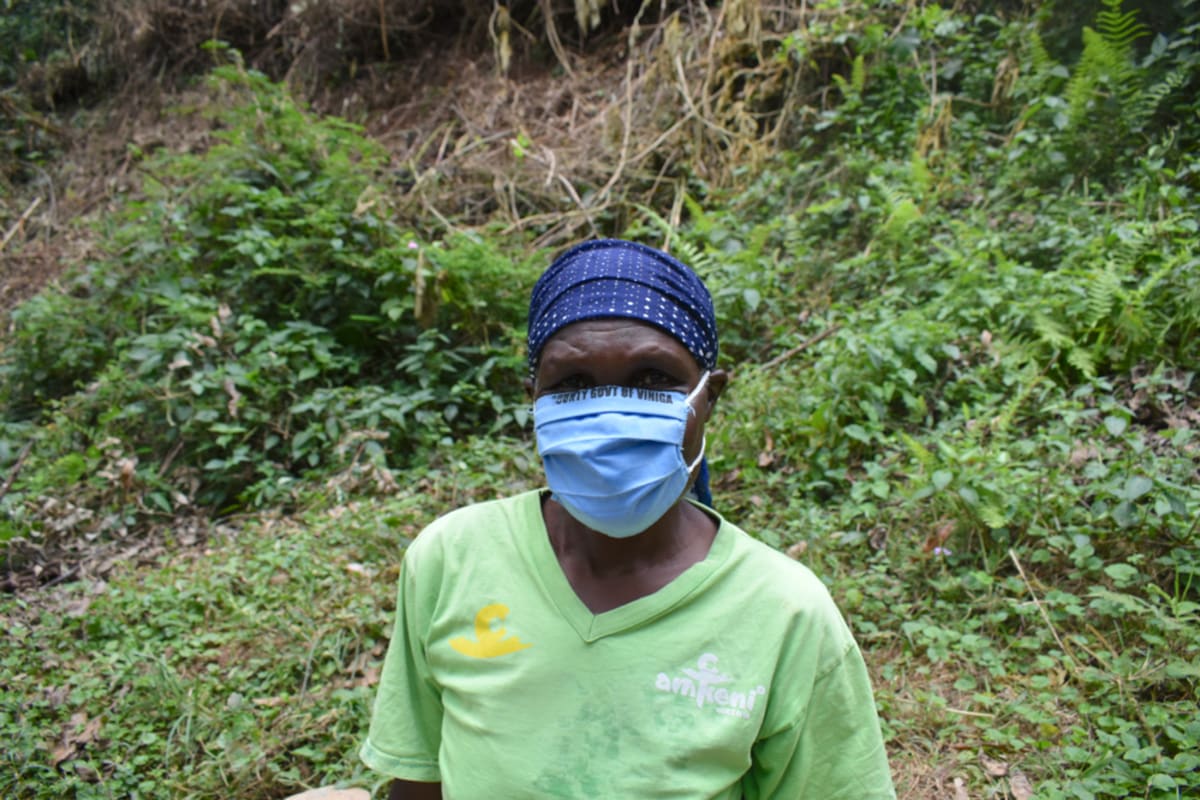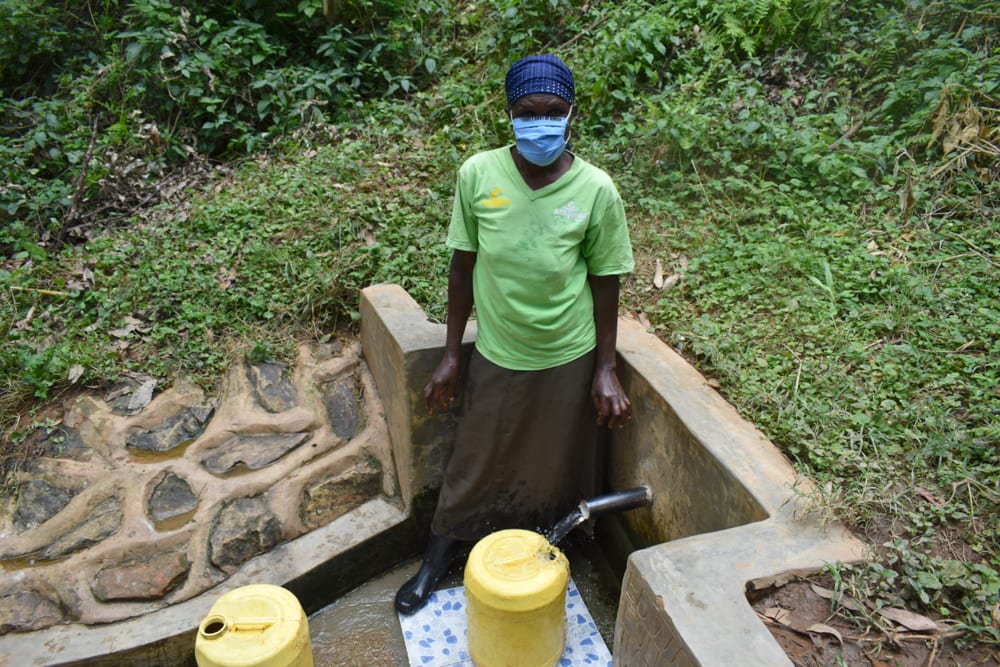May, 2020: COVID-19 Prevention Training Update at Kisasi Community, Sabwa Spring
Our teams are working on the frontlines of the COVID-19 pandemic. Join us in our fight against the virus while maintaining access to clean, reliable water.

We are carrying out awareness and prevention trainings on the virus in every community we serve. Very often, our teams are the first (and only) to bring news and information of the virus to rural communities like Kisasi, Kenya.
We trained more than 21 people on the symptoms, transmission routes, and prevention of COVID-19. Before there were any reported cases in the area, we worked with trusted community leaders and the Water User Committee to gather community members for the training.

We covered essential hygiene lessons:
- Demonstrations on how to build a simple handwashing station
- Proper handwashing technique
- The importance of using soap and clean water for handwashing
- Cleaning and disinfecting commonly touched surfaces including at the water point.

We covered COVID-19-specific guidance in line with national and international standards:
- Information on the symptoms and transmission routes of COVID-19
- What social distancing is and how to practice it
- How to cough into an elbow
- Alternative ways to greet people without handshakes, fist bumps, etc.
- How to make and properly wear a facemask.
During training, we installed a new handwashing station with soap near the community’s water point, along with a sign with reminders of what we covered.

Due to the rampant spread of misinformation about COVID-19, we also dedicated time to a question and answer session to help debunk rumors about the disease and provide extra information where needed.
We continue to stay in touch with this community as the pandemic progresses. We want to ensure their water point remains functional and their community stays informed about the virus.
Water access, sanitation, and hygiene are at the crux of disease prevention. You can directly support our work on the frontlines of COVID-19 prevention in all of the communities we serve while maintaining their access to safe, clean, and reliable water.

March, 2020: Kisasi Community, Edward Sabwa Spring Project Complete!
Kisasi Community now has access to clean water! Edward Sabwa Spring has been transformed into a flowing source of water thanks to your donation. We protected the spring, constructed 5 sanitation platforms for different households in the community, and we trained the community on improved sanitation and hygiene practices.
"This project is so helpful to us since we can now get clean water and stay healthy because many of us were being affected with the waterborne diseases and spent more cash on health, but now we know we are going to stay healthy and do more projects. Thank you," shared the spring's landowner Mr. Edward Sabwa.

Young boys enjoying the spring water upon the project's completion
Spring Protection
Community members provided all locally available construction materials, including bricks, wheelbarrows of clean sand, stones, and fencing poles. Accommodations and meals were provided for the artisan, and women and men lent their strength to the artisan to help with manual labor, too.

Community members help carry stones to the construction site
Early in the construction process, we noticed one young man in particular who was working very hard at the construction site every day. He said his name was Eugene. Eugene amazed the staff and this prompted them to find out the secret behind his hard work. Eugene then shared his story.
Since he was born, Eugene had always drunk dirty water from Edward Sabwa Spring. At one point, he suffered severe typhoid and had to stay away from school for such a long time. Eugene's father sought help to protect the spring, but all of his efforts proved futile.
Eugene's greatest motivation, he said, was that he had left this village with his dad 5 years ago to live in Eldoret. The week before we met him, his father had passed away and so Eugene decided to come back home to Kisasi. No sooner had he buried his father than he was informed about the protection of Edward Sabwa Spring. Eugene saw this as an opportunity to honor his dad who had worked tirelessly to ensure that one day, they would have clean water.
"My dad and the ancestors - wherever they are right now - they are proud of me and they are smiling. His death has brought water home. I will work hard to ensure that the spring is protected and also ensure that it is well maintained," added Eugene.
The Process
The spring area was excavated to create space for setting the foundation of thick plastic tarp, wire mesh, and concrete. After the base had been set, both wing walls and the headwall were set in place using brickwork. The discharge pipe was fixed low in place through the headwall to direct the water from the reservoir to the drawing area.

Community member helps pass bricks to the artisans
As the wing walls and headwall were curing, the stairs were set and ceramic tiles were fixed directly below the discharge pipe. This protects the concrete from the erosive force of the falling water and beautifies the spring. The process of plastering the headwall and wing walls on both sides reinforces the brickwork and prevents water from the reservoir from seeping through the walls and allows pressure to build in the collection box to push water up through the discharge pipe.

Artisan measures the discharge pipe's placement in the headwall
The source area was filled up with clean stones and sand and covered with a thick plastic tarp to prevent potential sources of contamination. Then soil was layered on top of the tarp so that community members could transplant grass to prevent erosion. Finally, the collection area was fenced in.

Planting grass and building fencing around the spring as water begins to flow
The only delays during the entire construction process occurred early on when frequent and heavy rains poured down on the day of brickwork and plastering, forcing the artisans to stop work for some hours. Work picked up again the next day when the weather was favorable, so the artisan recovered the lost time and work went on as planned.
It took about 2 weeks of patience for the concrete to dry. No sooner had clean water started flowing through the pipe after backfilling than the entire community came filled with excitement to gather at the spring. Our staff took this moment to remind the community members on the importance of maintenance and repair issues and then officially handed the spring over to the community.

Community members celebrate the spring along with Field Officer Karen Maruti, in center next to the discharge pipe
Sanitation Platforms
All 5 sanitation platforms have been installed. These 5 families are happy about this milestone of having a private latrine of their own and are optimistic that people will no longer leave waste outdoors. We are continuing to encourage families to finish building walls and roofs over their new latrine floors.

New sanitation platform owner
New Knowledge
Community member and spring landowner Edward Sabwa along with community leaders and the local pastor helped organize the training in coordination with our team. Together we found the community’s preferred date for training while considering other events in the community calendar such as the agricultural season and expected gatherings. We decided to hold training on the day of backfilling at the spring construction site to ensure that the community participated fully in the process of construction and understood how to take good care of the spring. Facilitators Karen Maruti and Amos Misiko then deployed to the site.
With only 18 people in attendance, we were surprised by the low turnout. We soon learned, however, that one of the residents of this community has passed away earlier that morning and thus most people had gathered at his home to comfort the bereaved family. Those who had shown up for training insisted it continue and that they would pass the knowledge gained onto their neighbors, so we proceeded with the day as planned.

Trainer Karen shows how to make and use a leaky tin for handwashing at training
The weather was sunny that day. We opted to conduct our training under the shade near the spring so that we could also conduct the practical sessions about site management and water handling at the spring site with ease. This was a very conducive environment for training.
We covered several topics including community participation; leadership and governance; personal and environmental hygiene; water handling and treatment; operation and maintenance of the spring and sanitation platforms; dental hygiene; the 10 steps of handwashing, and how to make and use a tippy tap and leaky tin. During the leadership and governance session, we held an election for the leaders of the newly formed water user committee.
We also brainstormed income-generating activities that can be used to start both a community savings account for any future minor repairs to the spring, as well as a cooperative lending group to enable members to develop their own small businesses. The community is in the process of starting their own official self0help group as well, which could help spearhead these new activities.

A woman demonstrates toothbrushing next to Trainer Amos
The participation of the women was greater than of the men, our facilitators noted, as they had to ask the men questions to get them to speak up. The whole group was interested and responsive the whole day, though.
The session on safe water handling was particularly memorable. Facilitator Karen picked up some leaves and threw them in the water and asked how many people had ever done that. All of the women raised their hands. Karen then probed them further, asking if they ever looked at the leaves keenly or washed them before inserting the leaves into the water. At this point, the women started staring at each other seeking answers. Karen then informed the group that by throwing leaves into their water, they could be consuming bird feces, dead insects, and all sorts of contaminants whether naturally occurring or not. The women started cursing and stated that they would never do that again! We also discussed the importance of not sitting on open water containers in case one has dirt on their clothes that could drop into the water.
Site management of the spring was another interesting topic. It was at this juncture that one woman stood up and stated that there is one particular stubborn lady in the community who constantly does her laundry at the spring and never adheres to the rules against it. Another person said she wanted to become a Community Health Volunteer just so she could deal with this stubborn person. The facilitator at this point encouraged the water and sanitation management committee to enact rules and regulations and enforce them for the sustainability of the spring.

Trainer Karen shows how to clean a jerrycan before using it to fetch water
When an issue arises concerning the water project, the water user committee is equipped with the necessary skills to rectify the problem and ensure the water point works appropriately. However, if the issue is beyond their capabilities, they can contact our team of field officers to assist them. In addition, we will continue to offer them unmatchable support as a part of our ongoing monitoring and maintenance program.
"Many of the members of this community could not access clean water in the past as the spring was unprotected. We were also ignorant of safe water handling practices...I am happy that we have learned [better] and will stop these behaviors for better health in our community," shared Added Vincent Lukaya, a farmer who attended training.

Ready to carry clean spring water home
After training, the community members were seen practicing water hygiene by washing their containers and covering them as they carried water home.
Thank you for making all of this possible!


 Protected Spring
Protected Spring
 Rehabilitation Project
Rehabilitation Project






































